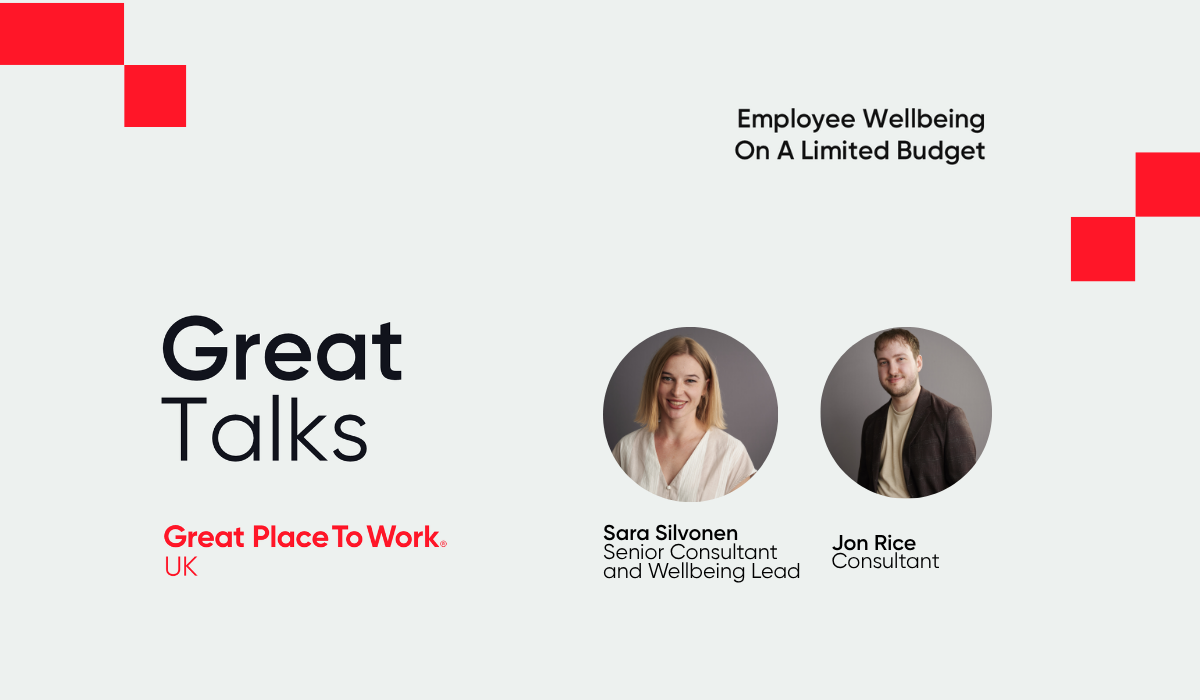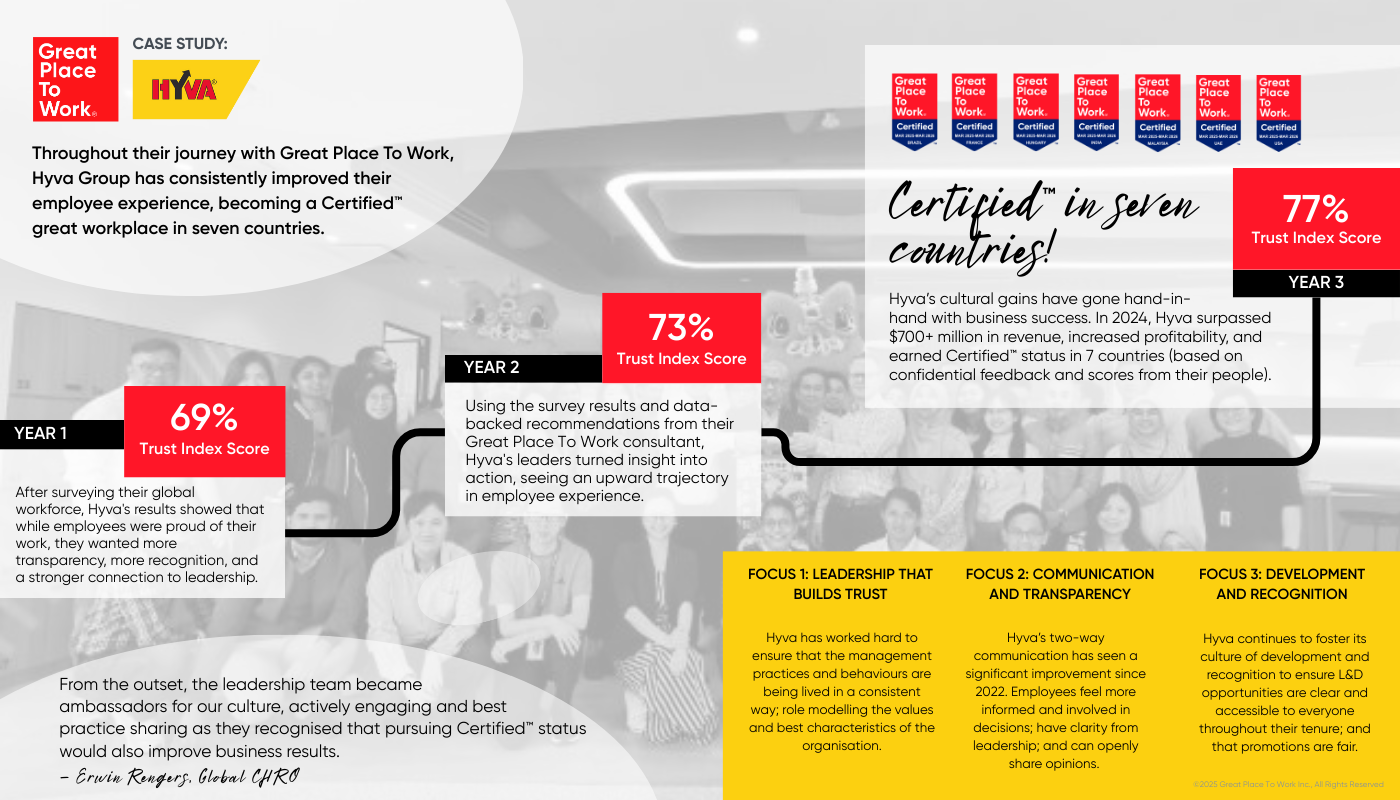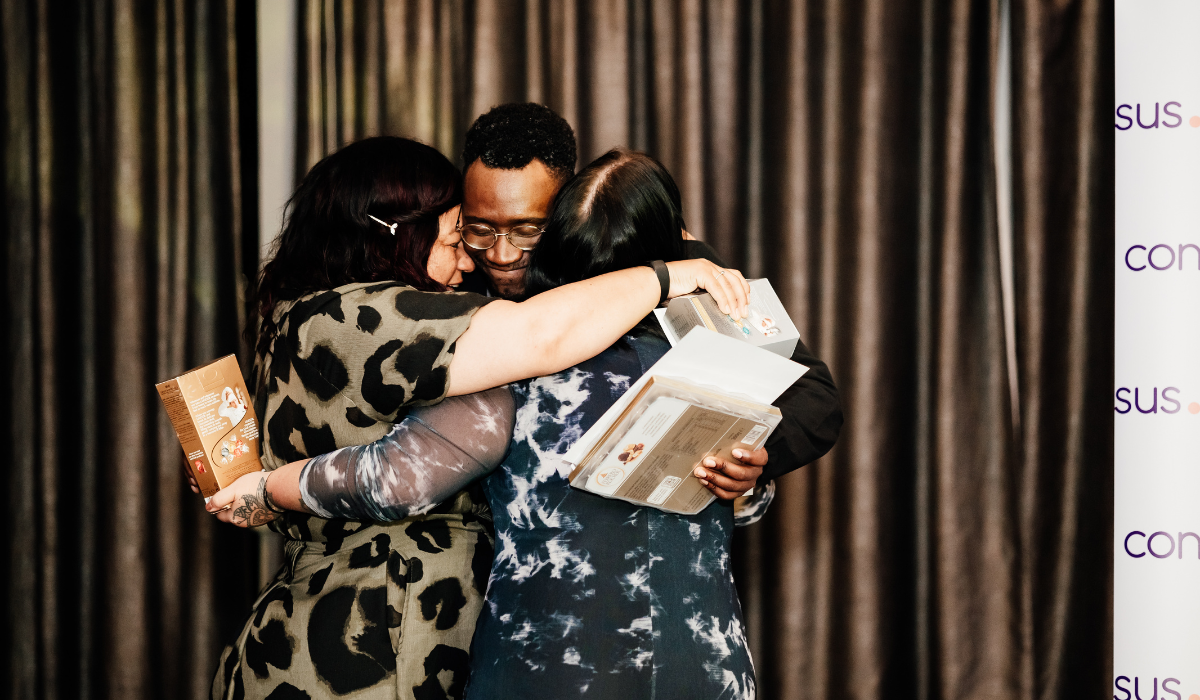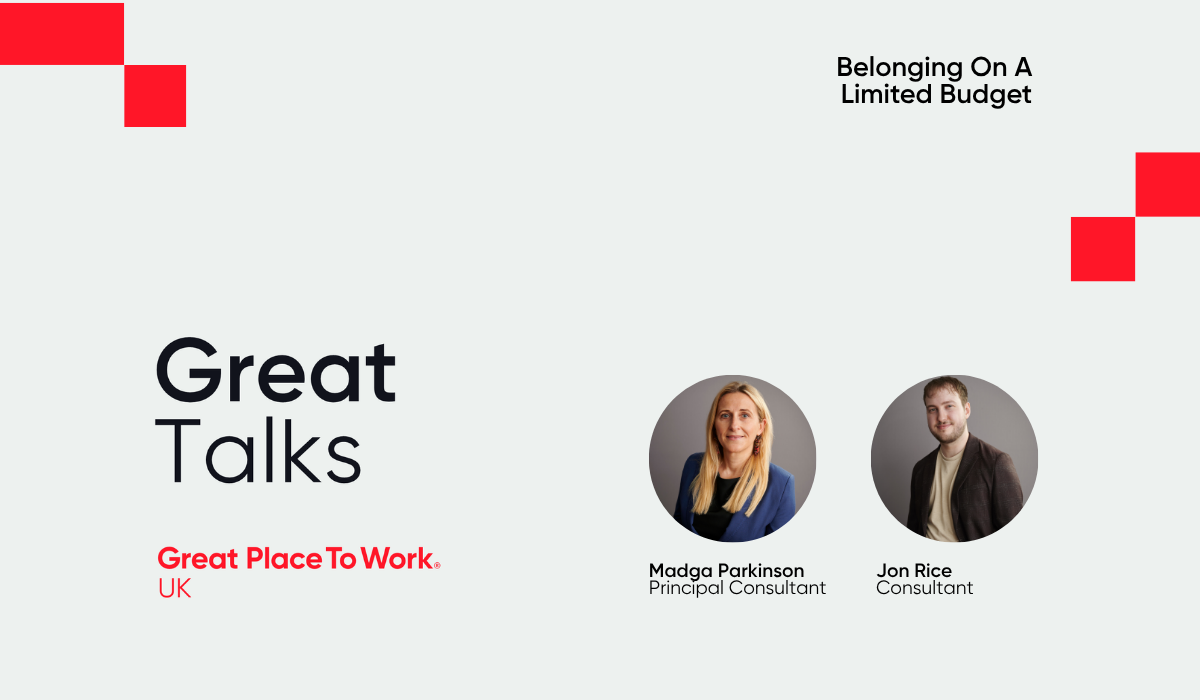Join us as we discuss practical strategies and insights on how to foster employee wellbeing without breaking the bank.
We know that many organisations share a common challenge: how to build and sustain a great company culture without the need for major financial investment.
But we believe every workplace, no matter their size or budget, can become a great place to work. In our new podcast series, On A Limited Budget, we'll be sharing tips and insights on how even the most budget-conscious businesses can create a healthy, happy, and productive workforce
In our first episode, we're exploring one key element of this critical challenge: fostering employee wellbeing without breaking the bank. Listen below as Great Place To Work UK Senior Consultant and Wellbeing Lead Sara Silvonen and Consultant Jon Rice dive into ways you can support employees, prevent burnout, and empower managers to enhance employee wellbeing:
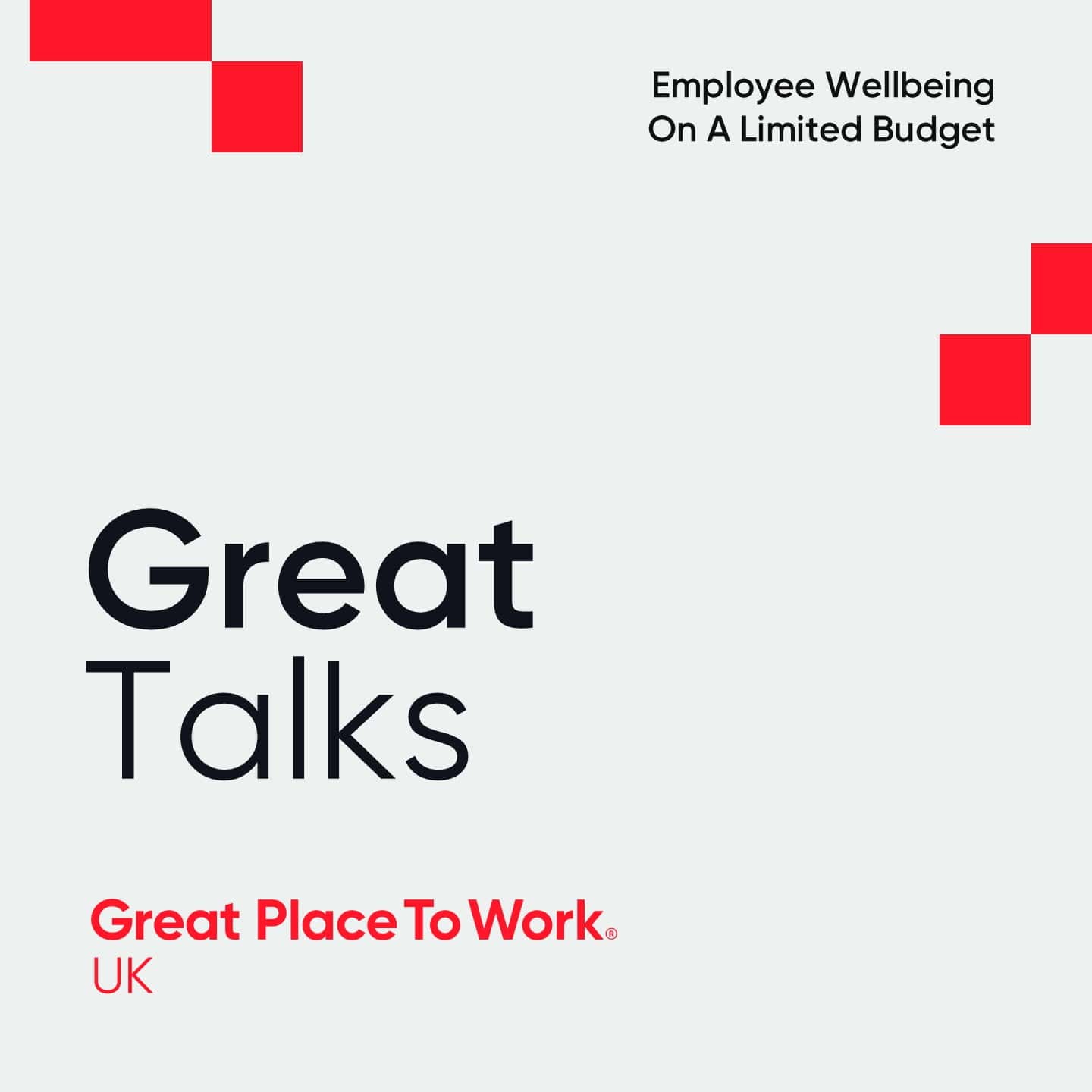
|
|
|
Key Takeaways
Untangling wellness and wellbeing
It's tempting to refer to wellness and wellbeing interchangeably, says Sara. But "when we talk about wellness, it is more about getting people to this momentary state of good health through various self-care practices, whereas wellbeing is a more holistic, overarching concept – how do we get people to thrive at work?"
And for organisations on a budget, this is good news. "A lot of these perks and programs and snazzy initiatives that we see associated with wellness – things like private medical insurance or fancy gym memberships or mindfulness apps – they do often come at a cost, sometimes a significant one. Whereas if we think about wellbeing on this more fundamental level and focus on the basics, that often comes at low or even no cost and actually often has the most impact at the end of the day."
A culture of care
One of the most important thing organisations with a limited budget can do to foster wellbeing is build a culture of care and camaraderie, explains Jon:
"Things like lunchtime events, listen and learns, and those small things that bring people together and create that sense of community at the workplace, they help people feel like the organisation cares about them. They also build those relationships between themselves and their colleagues, and they feel like their colleagues care about them too.
That feeling of care is probably the most fundamental piece of wellbeing in organisations, people feeling like they're cared about and that their actual feelings matter. And when you have that in place, people will be more willing to speak up and air concerns and really get to the core of any wellbeing issues you have way quicker than if that culture of care isn't in place."
Empowering managers
"Managers, especially frontline managers, they play such a key role in virtually all parts of the employee experience: development, talent management, all these things. But when it comes to wellbeing, they are the real MVPs," explains Sara.
"We see this all the time in open-ended comments when we ask people ‘what's the best way your organisation can support your personal wellbeing?’. Surprisingly, many just say, ‘I wish my manager would talk to me more’.
So I'd say that the very first thing you can do, on no budget to begin with, is to make sure that your staff who have people management responsibilities are aware of that – as in, the power that they hold just by being people managers. When those wellbeing issues crop up, as they inevitably will at some point, it is so much easier to have those conversations if they're built on this foundation of trust and good rapport between direct reports and line managers."
Show Transcript
Beth: Hello, and welcome to the first episode of our new podcast series: On A Limited Budget. I'm Beth, Content Manager at Great Place to Work UK, and I'll be your host today.
Great Place To Work is the global authority on workplace culture. Every year, we get direct feedback from over 10 million employees around the world, working across a range of companies in various industries and sizes, telling us how they really feel about their employer.
Diving into the data, we noticed that many organisations share a common challenge: how to build and sustain a great company culture without the need for major financial investment. Today we're exploring one key element of this critical challenge: fostering employee wellbeing without breaking the bank.
In a time when budgets are tight and employee needs are diverse, it's more important than ever to create a workplace culture that supports wellbeing. I'm joined by Senior Consultant and Wellbeing Lead Sara Silvonen and Consultant Jon Rice. During our conversation, you'll hear Sara and Jon share some practical strategies and insights on how to support employees, prevent burnout, and empower managers to enhance employee wellbeing.
From job design to leadership behaviours, we'll discuss the most effective ways to build a culture of wellbeing that benefits both employees and the organisation as a whole. Join us as we explore employee wellbeing on a limited budget, and discover how even the most budget conscious businesses can create a happy, healthy, and productive workforce.
So let's start with the basics: How do we at Great Place To Work, define wellbeing?
Sara: Yeah, so that's a really important question to start with because as we all know, it is such a mammoth term and a really broad topic. We're really talking about the experience of being well, ideally, where everyone can be their most productive, high performing, thriving versions of themselves in the workplace, right?
We are not sort of philosophically debating what wellbeing or happiness is. We're talking about workplace-specific wellbeing and what employers can do specifically. So I'd say, in a nutshell, it is about creating the conditions for employees to thrive in. That's what employers should take it as. And I'd really encourage people to start untangling that concept of wellbeing from wellness, which is tempting to use interchangeably, but when we talk about wellness, it is more about getting people to this momentary state of good health through various self-care practices, whereas wellbeing is a more holistic, overarching concept, which is what we'll try to focus on today – how do we get people to thrive at work?
Beth: And could you explain a little bit more about why wellbeing is so important?
Sara: Sure. I mean, there's a ton of evidence and research about this. I like to split it into this sort of carrot and stick argument.
So in its simplest terms, there are all these costs like sickness, absence, presenteeism, and turnover that are associated with poor employee wellbeing. That's the stick, that's what you want to avoid. And then on the other hand, there are all these benefits. Like discretionary efforts, loyalty, productivity, employer branding, retention, all these things that we see associated with good employee wellbeing.
And that's the carrot. That's what we want to see. And then I'd just say generally, besides employers having a duty of care and just it being the right thing to do, it comes down to the concept of sustainability as well. So yes, you can work your employees to the bone and you can probably get great results for a short period of time. But that's just not going to be sustainable in the long run, is it? So you have to nurture their wellbeing if you want to be a sustainable organisation.
Jon: And this also plays into talent management as well. So if people aren't feeling that sustainable level of wellbeing in the workplace, they are more likely to leave, simply put. And you'll have a higher level of attrition. And people talk – it can be shown on things like Glassdoor reviews and stuff like that – so people will also be less likely to join the organisation as well. So it's really that talent attraction and talent retention piece as well in there.
Beth: Okay, so we know wellbeing is a vital part of building a thriving culture, but a lot of people assume that it requires a lot of investment. But we work with clients ranging from small to super large organisations with all sorts of differing budgets. How have you seen organisations on a more limited budget approach wellbeing?
Sara: Yeah, so this is where I'd say that distinction between wellbeing and wellness really comes in handy because a lot of these sort of perks and programs and snazzy initiatives that we see associated with wellness – things like private medical insurance or fancy gym memberships or mindfulness apps – all these things, they do often come at a cost. Sometimes a significant one. Whereas if we think about wellbeing on this more fundamental level and focus on the basics, that often comes at low or even no cost and actually often has the most impact at the end of the day. So there's this misconception that to do wellbeing well as an organisation, you need to be involved in all areas of people's personal health and wellbeing, their physical health, their nutrition, their sleep hygiene, their mental health, their financial wellbeing.
And it's great if you are, but you don't need to do that as an employer. The best thing you can do is just to ensure that people's jobs and their work environments aren't detrimental to their wellbeing. And ideally, they're actually actively contributing to that wellbeing. So it really comes down to the fundamentals of having psychological safety, job design, resourcing, having good managerial relationships, and building a sense of community at work.
And I'd say those are the things that our smaller organisations that often have limited budgets for this, that's the stuff that they get right. And you work with a lot of those organisations, don't you, Jon?
Jon: I do, and it definitely rings true. I've worked with a lot of organizations and spoken to individual employees where they have those wellness pieces, the things like yoga, mindfulness platforms, financial wellbeing seminars, and whilst they do help in a micro way, the more macro, substantial things like stress management, like allocation of work aren't prioritised by the organisation, and this leads to these things ringing hollow and people feeling like they're false and more like marketing plasters over the fundamental cracks of the organisation. So definitely, that sort of core piece of managing people's stress in the workplace is definitely a thing that should be prioritised there.
Sara: And that was such a nice way you put it to me last week: these little things, the cute little things, they're wellbeing adds – they're not wellbeing makers.
Jon: Absolutely, absolutely. And as well as this, a lot of these small organisations focus on building that culture of camaraderie and fun in the workplace through things like perhaps lunchtime events, listen and learns, and those small things that kind of bring people together and create that sense of community at the workplace, and that helps people feel like the organisation cares about them, but also builds those relationships between themselves and their colleagues, and they feel like their colleagues care about them too. Because that feeling of care is probably the most fundamental piece of wellbeing in organisations, people feeling like they're cared about and that their actual feelings matter.
And when you have that in place, people will be more willing to speak up and kind of air these concerns and really get to the core of any wellbeing issues you have way quicker than if that culture of care isn't in place.
Sara: Yeah, and it's more real, it's that human touch.
Beth: And on that note of building a culture of care – from our own research at Great Place To Work, we've seen that managers play an important role in employees' wellbeing. What are some everyday actions that people managers can take to create a healthy workplace environment?
Sara: 100%. Managers, especially frontline managers, they play such a key role in virtually all parts of the employee experience: development, talent management, all these things. But when it comes to wellbeing, they are the real MVPs, of course. We see this all the time in open-ended comments when we ask people ‘what's the best way your organisation can support your personal wellbeing?’ Many of them say, surprisingly, many just say, ‘I wish my manager would talk to me more’. So I'd say that the very first thing you can do with on no budget to begin with is to make sure that your staff who have people management responsibilities are aware of that – as in, the power that they hold just by being people managers, and that they, like Jon said, they take the time to get to know their team, they spend time with their team, which I know is particularly challenging in a virtual setup or in a hybrid setup. But arguably then even more important to really put in that effort to do so because like he said, when those wellbeing issues crop up, as they in inevitably will at some point, it is so much easier to have those conversations if they're built on this foundation of having this trust and this good rapport between direct reports and line managers.
I'd also encourage managers to build in structured touch points, so one-to-ones at least semi-regularly, and to make sure that they're really listening actively in those one-to-ones. And then of course it helps if they know roughly what kind of signs and symptoms to look out for if people are struggling with anything and that they feel comfortable in having those conversations.
But I'd say the really simple things, just getting to know people on a personal level, taking the time, listening actively, they count for a lot.
Jon: Absolutely. And there's a common adage in our field that your line manager has a greater effect on your overall health than your GP does. So a little cliche, but it is very true.
So definitely prioritising that sort of leadership training and building that atmosphere is very important. As well as this, it's really good to come at things from more of a communication angle and kind of have those bottom up communication methods, whether through dedicated email addresses that people can email with their names on, or anonymous suggestion boxes.
Giving employees the opportunity to voice their concerns and give feedback, whether again anonymised or otherwise, to show where wellbeing could perhaps be improved, but also where wellbeing issues are occurring and really get that crucial information so you can do something about it.
Beth: And we also know that stress and burnout are key factors that impact many employees across the UK. Have you seen any creative strategies that companies have utilised to either prevent this or support those experiencing these symptoms?
Sara: Yeah. So just to begin with conceptually on that, as you sort of implied in your question, it is important to differentiate between, making sure you have proactive and reactive approaches to stress and burnout risk.
But let's be clear, it's always better to try prevent things from happening than dealing with them once they already have. So we're going to focus more on that preventative piece, I think, and that is all about building these psychologically safe and healthy work environments with stress reduction habits built into the ways of working and daily workflows. And that can be as simple as just making sure people are building in regular break times into their work days and really encouraging this kind of behaviour from the top. So managers role modelling taking micro breaks during the day, maybe even incentivising people to do this in, in various ways.
And then also encouraging the use of focus time through various do not disturb signals and having guidelines when people are expected to be responsive, but then also setting boundaries for their time outside of work. Also, really important to empower people to prioritise as well as deprioritise. So dropping things off the list or saying no to things because that is a sure way to get extremely stressed if you feel like you have to take everything on and you cannot say no.
And things like auditing your meeting and comms culture as well will go a long way towards reducing stress from the outset and with all of the above, I think role modelling by managers, by leaders, that's a really powerful way of saying ‘this is how we work around here – we prioritize wellbeing from the outset’.
So if you can show any vulnerability, if you can share your own stress management techniques as a people manager instead of just being busy all the time that is really going bring some humanity into the room and work wonders.
Some of our clients are also really good at leveraging technology for stress monitoring. I have a tech consultancy client, quite a small one, who told me about a weekly stress check that they conduct on Teams, on their Tuesday morning standup, where they simply ask two questions: How is your workload and how stressed are you feeling? People answer on a scale of one to five, and if anyone is scoring four or above, they're encouraged to speak to someone, which sort of brings in that people management piece again.
Jon: And I've seen very similar to that small tech consultancy in some of my own clients, but more of a traffic light system. So especially for small teams, it works well. They check in every day. Green is ‘my wellbeing's great, my stress management's great’. Orange is ‘I might need a little help, or just a sort of casual conversation to pick me up’ and red is ‘I need some help’. And normally that's when they would also contact their line managers and get them involved.
So there's definitely ways of, particularly in remote teams, maintaining those small indicators that we take for granted in physical offices. As well as this in remote teams, it's good to have dedicated channels that are for more casual conversation. Things like pet pictures or movie discussions and things like that, just to kind of give people that water cooler talk that might be missing in remote teams and give again, a sense of people to build that camaraderie, build those relationships with their colleagues.
Sara: They're all good wellbeing reminders, as we said, isn't it?
Beth: So you mentioned stress monitoring there. What are some of the other ways you would measure levels of wellbeing in an organisation, and particularly measure success when it comes to wellbeing?
Sara: Hmm, it's a good question and one we get asked quite a lot and doesn't really have a simple answer necessarily. There's a few ways you can go about it.
There are the more, sort of indirect ways that are a bit more numerical or objective. So you could measure sickness absence levels. You could measure the length of average sickness absence, the reasons people are giving. You could look at usage data of medical insurances, claims, people using your employee assistance programs, the reasons for that. Or you could just look at organisational productivity and performance metrics. All these things are probably pretty difficult for smaller organisations on a more limited budget to do however. So I would say the more direct measures are probably the most useful.
So these are things like just looking at scores or sentiment from internal surveys. If you ask about wellbeing, engagement, how people are feeling at work, just sort of tracking that data, over time, maybe after you've implemented a new people management training course or something like that. For example, if you wanted to compare before and after, you could simply ask in one-to-ones between people and their line managers or in team meetings or in all staffs, like we've said, having a sort of traffic light system or a stress monitoring system, a simple pulse item, just ask how people are feeling. Just measuring sentiment in really simple ways like that often gives you the sort of most sort of rich data.
Jon: I definitely agree wellbeing's one of those things that is hard to measure the success of it because you can quite easily measure the failures of it – when people are showing all those warning signs and you can look around the room and see that people are struggling, but it's harder when you kind of look around the room and see everyone's happy. So I would definitely, give a word of caution like, don't rest on your laurels. Just because you're not experiencing wellbeing issues doesn't mean you shouldn't make sure you're getting that employee voice and hear from people and do these sorts of pulse checks when you can. Because things might be bubbling under the surface. But as well as this, if you do do these checks, make sure you do them often and do them at various points in time as well.
I have had clients before that have done these things. They score poor wellbeing scores, particularly in the winter time and they sort of panic. But what has happened is that everyone's sick. They've got thr winter flu that we always seem to have and that really affects their wellbeing. Or it was really bad weather that morning and everyone was miserable by the time they got to the office and things like that.
So make sure we have those temporal checks as well to make sure it's not just a little blip here and there.
Beth: Okay. And just to wrap up everything that we've been discussing today, if you were to give people leaders one initial step to focus on for implementing wellbeing on a limited budget, what would it be?
Sara: I would say don't overthink it and don't over complicate it. I would really encourage people – boring as it may sound – to really invest in those simple, day-to-day, arguably boring sounding things, but that have the biggest impact, and do also conveniently come at usually the lowest cost. Above all, ensure that your people managers are up to scratch with their people management skills and look at upskilling if they are not, and if you're going to invest in those cute little things, all the perks, all the sort wellness side of things, then you can do that after you've looked at the fundamentals.
But there's a clear chronology of actions there, and that chronology really matters. What would you say, Jon?
Jon: I would absolutely say following up from what we said earlier, to empower your line managers. Really kind of focus on giving some time and investment in skills as well, and giving your line managers the sort of necessary toolbox to be able to have those wellbeing conversations, to be able to check in on their managees and see how they're feeling and to know the warning signs of negative wellbeing or overstress.
And along those lines as well as this, it's, whilst empowering those line managers to look after their teams, also empowering line managers to look after themselves. One thing we often see in a lot of organisations across size categories, across sectors in the UK is the squeezed middle effect, as we call it at Great Place To Work. This is particularly line managers who have much lower scores for their wellbeing in comparison to other managerial groups. And often this is because they have their primary roles where they're doing their day-to-day job, their managerial role tacked on top of that, and then they have pressures coming from below them, from their managees, but also above them from the mid-level managers, from the executive team. So they can often feel squeezed between a rock and a hard place, and this can cause them to feel overstressed and have a negative impact on their wellbeing. So it's empowering those line managers to be able to look after themselves primarily, but also know the structure for reporting their own wellbeing experiences up the ladder and knowing where to turn to and making sure there's just as much focus on them as their managees below them as well.
Beth: Well, thank you both for being here today. This has been a really insightful discussion and to our listeners, hopefully you’ve gained some helpful tips and tricks for how you can build a culture of wellbeing on a limited budget.
Thank you so much for tuning in - make sure you’re subscribed wherever you get your podcasts, and signed up to our newsletter so you get notified when our next episode is live, where we’ll be talking about Employee Development on a Limited Budget - and to find out more about how we can help you measure and improve your company culture, visit us at greatplacetowork.co.uk.
